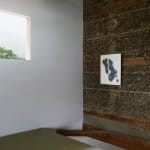Morita Shiryū (1912–1998)
Monoui
Ink on paper, framed
1963
With a label signed by the artist
47 x 38 cm
50 x 40 cm (overall)
1963
With a label signed by the artist
47 x 38 cm
50 x 40 cm (overall)
Exhibitions
1st Thirty Contemporary Japanese Calligraphers Exhibition. Tokyo: Shinjuku Isetan, 1963.Literature
Bokubi. 123. Kyoto: Bokubisha, 1963.The Works of Shiryu Morita: Selected by the Artist. Kyoto: Bokubisha, 1971.
Morita Shiryu Catalogue Raisonné: 1952–1998. Uji: Soryusha, 2019.
Monoui is also pronounced rai and means “languid.” Its connotations are not entirely positive, which may be a reason that in calligraphy it is rarely taken up as a subject matter for single-character works. This work was included in the 1963 group exhibition Thirty Contemporary Japanese Calligraphers. Morita wrote the character multiple times, and in the catalog of his solo exhibition at Mi Chou Gallery in New York he explains the meaning of monoui as “languishing / detached from worldliness.” While “languishing” is a more conventional translation for monoui, the second part of the phrase is uniquely Morita’s own interpretation. This work’s inclusion in the artist’s 1971 self-selected catalog of works attests to how important it was to him.
In the catalog, he further adds: “(languid) for me usual patterns are life denying; there are more pressing problems of a higher dimension.” Interestingly, such explanations or comments by the artist are limited to the English language; he wouldn’t elaborate on the titles in his native Japanese. Morita’s characters were built on their lexical meaning in the first place, but he would unfailingly twist them with his own point of view. Anticipating an international audience, he invested additional effort to transmit his intentions. These comments thus constitute important material for his interpretation even from a Japanese perspective.
Morita Shiryu (avant-garde calligrapher; 1912–1998)
Avant-garde calligrapher from Hyogo Prefecture. Like fellow artist Inoue Yuichi, Morita studied under the calligraphy master Ueda Sokyu. He co-founded the avant-garde group Bokujinkai together with Inoue and was the founder and editor of the journal Bokubi (Beauty of Ink), both of which revolutionized traditional Japanese calligraphy and spread knowledge of Japanese avant-garde calligraphy to an international audience. He was posthumously awarded the Medal of Honor with Dark Blue Ribbon.
In the catalog, he further adds: “(languid) for me usual patterns are life denying; there are more pressing problems of a higher dimension.” Interestingly, such explanations or comments by the artist are limited to the English language; he wouldn’t elaborate on the titles in his native Japanese. Morita’s characters were built on their lexical meaning in the first place, but he would unfailingly twist them with his own point of view. Anticipating an international audience, he invested additional effort to transmit his intentions. These comments thus constitute important material for his interpretation even from a Japanese perspective.
Morita Shiryu (avant-garde calligrapher; 1912–1998)
Avant-garde calligrapher from Hyogo Prefecture. Like fellow artist Inoue Yuichi, Morita studied under the calligraphy master Ueda Sokyu. He co-founded the avant-garde group Bokujinkai together with Inoue and was the founder and editor of the journal Bokubi (Beauty of Ink), both of which revolutionized traditional Japanese calligraphy and spread knowledge of Japanese avant-garde calligraphy to an international audience. He was posthumously awarded the Medal of Honor with Dark Blue Ribbon.



